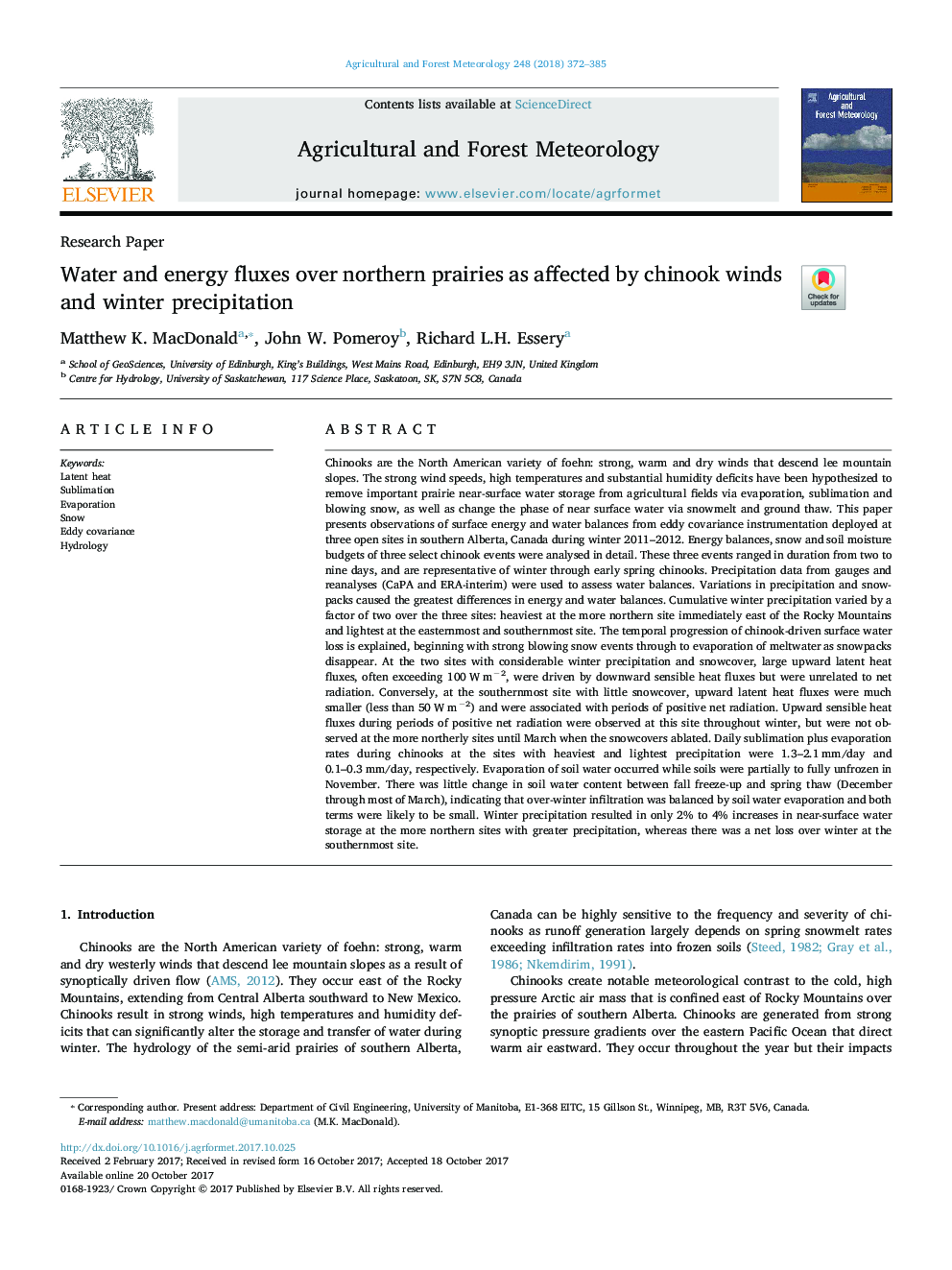| کد مقاله | کد نشریه | سال انتشار | مقاله انگلیسی | نسخه تمام متن |
|---|---|---|---|---|
| 6536882 | 1420853 | 2018 | 14 صفحه PDF | دانلود رایگان |
عنوان انگلیسی مقاله ISI
Water and energy fluxes over northern prairies as affected by chinook winds and winter precipitation
ترجمه فارسی عنوان
جریان آب و انرژی بر روی پریاهای شمالی که تحت تأثیر باد چینوک و بارش زمستان قرار دارند
دانلود مقاله + سفارش ترجمه
دانلود مقاله ISI انگلیسی
رایگان برای ایرانیان
کلمات کلیدی
موضوعات مرتبط
مهندسی و علوم پایه
علوم زمین و سیارات
علم هواشناسی
چکیده انگلیسی
Chinooks are the North American variety of foehn: strong, warm and dry winds that descend lee mountain slopes. The strong wind speeds, high temperatures and substantial humidity deficits have been hypothesized to remove important prairie near-surface water storage from agricultural fields via evaporation, sublimation and blowing snow, as well as change the phase of near surface water via snowmelt and ground thaw. This paper presents observations of surface energy and water balances from eddy covariance instrumentation deployed at three open sites in southern Alberta, Canada during winter 2011-2012. Energy balances, snow and soil moisture budgets of three select chinook events were analysed in detail. These three events ranged in duration from two to nine days, and are representative of winter through early spring chinooks. Precipitation data from gauges and reanalyses (CaPA and ERA-interim) were used to assess water balances. Variations in precipitation and snowpacks caused the greatest differences in energy and water balances. Cumulative winter precipitation varied by a factor of two over the three sites: heaviest at the more northern site immediately east of the Rocky Mountains and lightest at the easternmost and southernmost site. The temporal progression of chinook-driven surface water loss is explained, beginning with strong blowing snow events through to evaporation of meltwater as snowpacks disappear. At the two sites with considerable winter precipitation and snowcover, large upward latent heat fluxes, often exceeding 100Â WÂ mâ2, were driven by downward sensible heat fluxes but were unrelated to net radiation. Conversely, at the southernmost site with little snowcover, upward latent heat fluxes were much smaller (less than 50Â WÂ mâ2) and were associated with periods of positive net radiation. Upward sensible heat fluxes during periods of positive net radiation were observed at this site throughout winter, but were not observed at the more northerly sites until March when the snowcovers ablated. Daily sublimation plus evaporation rates during chinooks at the sites with heaviest and lightest precipitation were 1.3-2.1Â mm/day and 0.1-0.3Â mm/day, respectively. Evaporation of soil water occurred while soils were partially to fully unfrozen in November. There was little change in soil water content between fall freeze-up and spring thaw (December through most of March), indicating that over-winter infiltration was balanced by soil water evaporation and both terms were likely to be small. Winter precipitation resulted in only 2% to 4% increases in near-surface water storage at the more northern sites with greater precipitation, whereas there was a net loss over winter at the southernmost site.
ناشر
Database: Elsevier - ScienceDirect (ساینس دایرکت)
Journal: Agricultural and Forest Meteorology - Volume 248, 15 January 2018, Pages 372-385
Journal: Agricultural and Forest Meteorology - Volume 248, 15 January 2018, Pages 372-385
نویسندگان
Matthew K. MacDonald, John W. Pomeroy, Richard L.H. Essery,
